As an Amazon Associate I earn from qualifying purchases.
Harvesting elderberries is a rite of summer or early autumn for people all over the United States, Canada and Europe. Here are some tips and tricks for harvesting elderberries when it’s elderberry season near you.
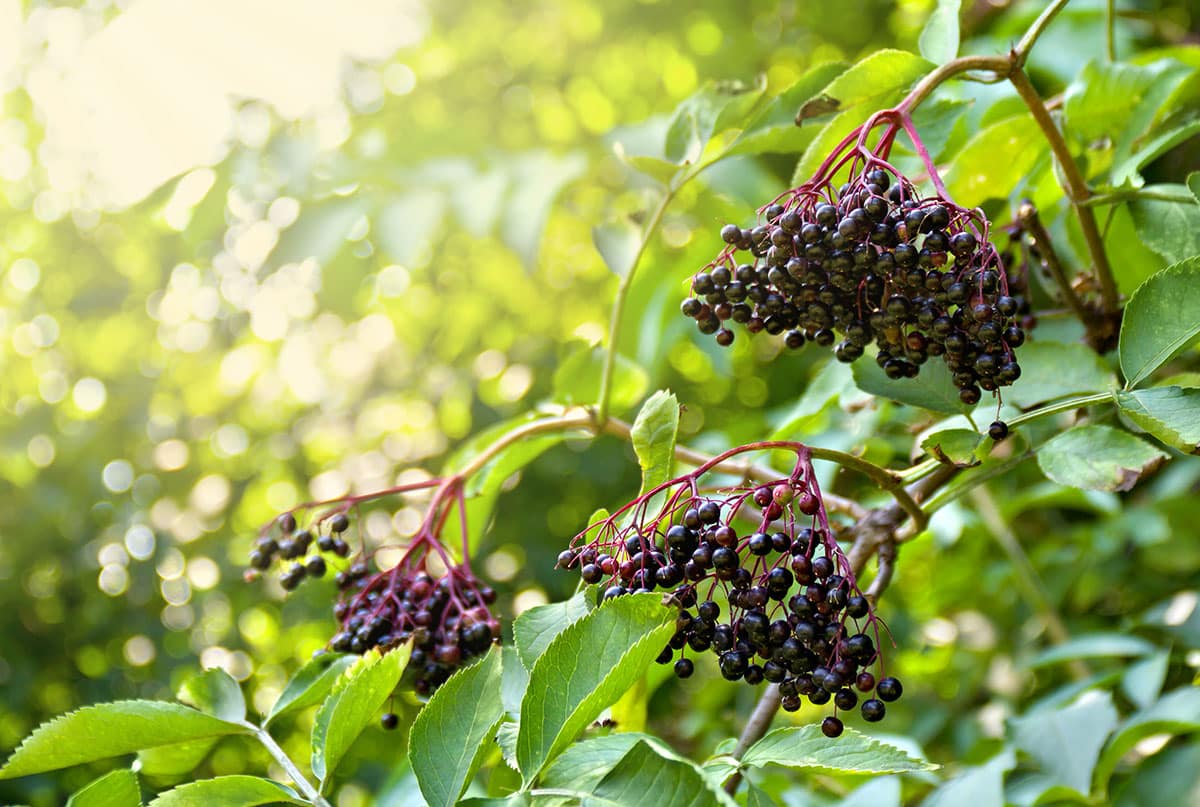
First off, I am talking about black or blue elderberries, which are Sambucus nigra, which has several subspecies. I don’t like red elderberries, which are S. racemosa, but some people do. This article doesn’t cover them.
Second, I am talking about ripe berries, not elderflowers, which come earlier in spring. If that’s what you’re looking for, I have recipes for elderflower cordial, elderflower fritters and elderflower liqueur elsewhere on this site.
Finding Elderberries
Most of the 5o states, as well as parts of Mexico and Canada, as well as all of Europe have elderberries. This guide from the USDA should get you started on finding elderberries.
Elderberries like to live near water, but not be wet. I find them near rivers a lot, on well watered mountainsides, even in large hedgerows in places like France and England. They are a large bush or sometimes a small tree — there’s a 20-foot tree living near my home in Folsom, California.
The berries are on large bunches, and will often droop down when they are getting ripe. I’ve never seen elderberry season start before May, even in Florida, although in recent years things have been ripening earlier and earlier.
In most places, elderberries don’t come ripe until September, but in the South and Southern California they can ripen as early as May, and here in NorCal we start getting ripe elderberries in late June. Elderberry season starts in earnest in the Sierra Nevada in September, as you get higher in altitude.
So depending on where you go, you can get ripe elderberries from May until November.
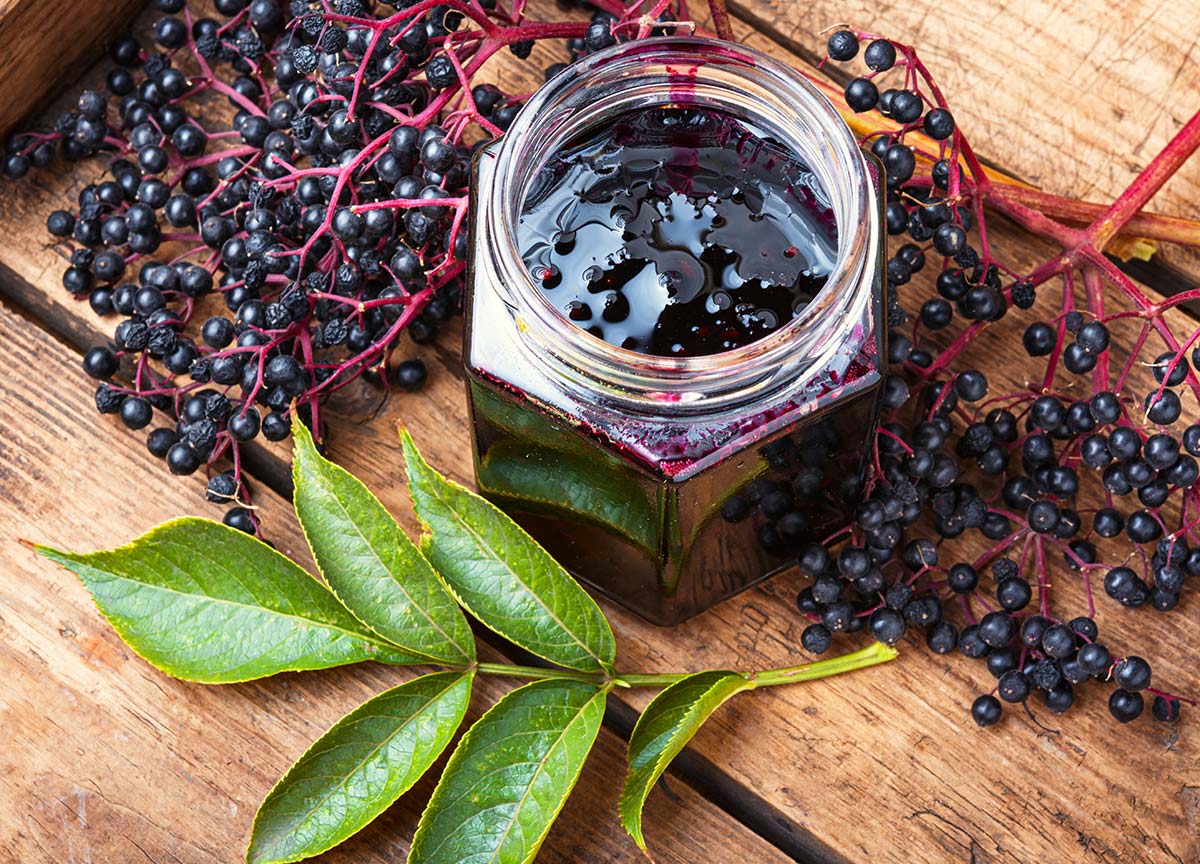
This photo shows elderberry leaves really nicely, as well as the ripe berries. Note the red stems. This is key. Harvesting elderberries before they are fully ripe will give you problems when it comes time to remove them from the stems. Ask me how I know. These are still unripe:
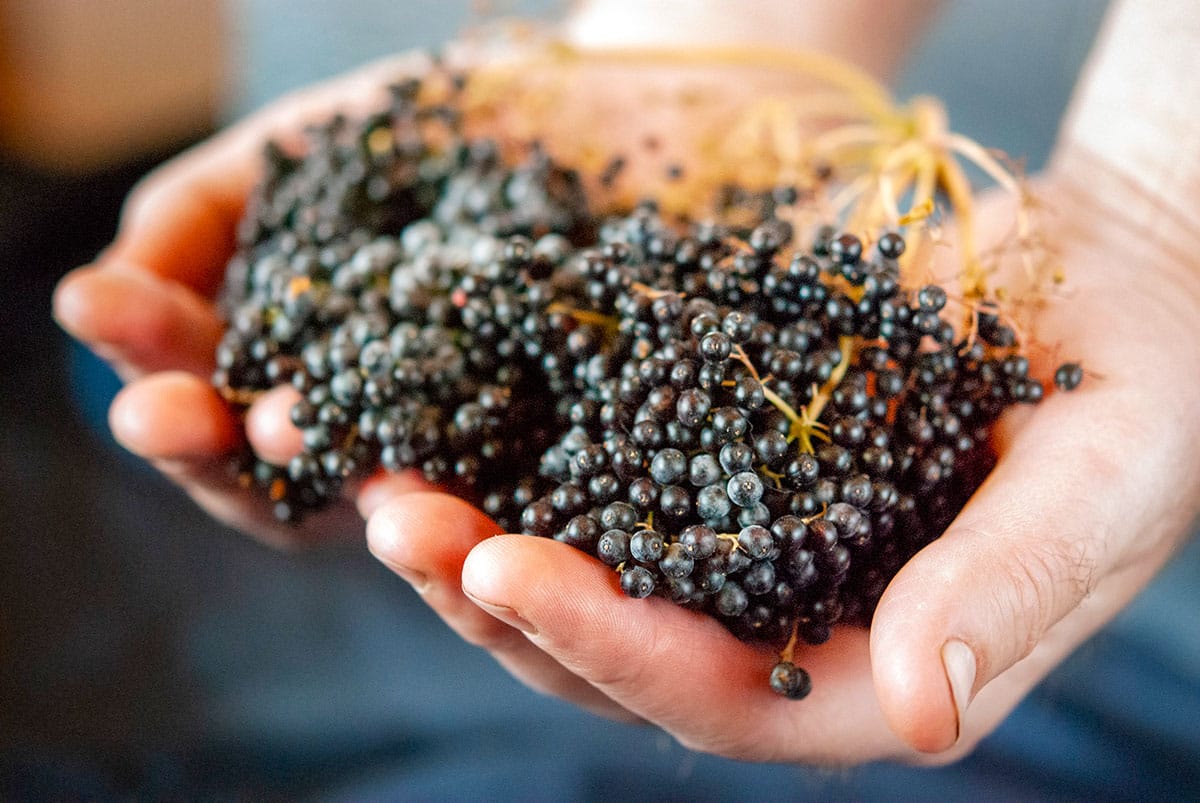
See the green stems? Yeah, they were a bear to get off the stem.
Harvesting Elderberries
The secret to elderberries, it seems, is that they are a rolling bush: Parts of some bushes are still in flower while the berries below have already ripened. Even when I picked my stash of elderflowers in May there were green berries on some.
Incidentally, you should know that the stems and unripe berries are toxic — not horribly so, but you want to minimize them in any elderberry recipe — and some people get an upset stomach eating raw elderberries. I do not, but some I know to.
Beware, slackers! Ripe elderberries are sweet — sweet enough that the deer like them very much. We saw a lot of nibbled-off spots on the bushes while harvesting elderberries in summer. By September I suspect the only remaining elderberries will be too high for the deer to get; and then you need to worry about birds.
I use a knife or scissors to cut off the bunches, collecting them in a paper grocery bag. Gather several bags, so you have plenty to work with.
Once you get your elderberries you need to take the berries off the stem, which can take some time.
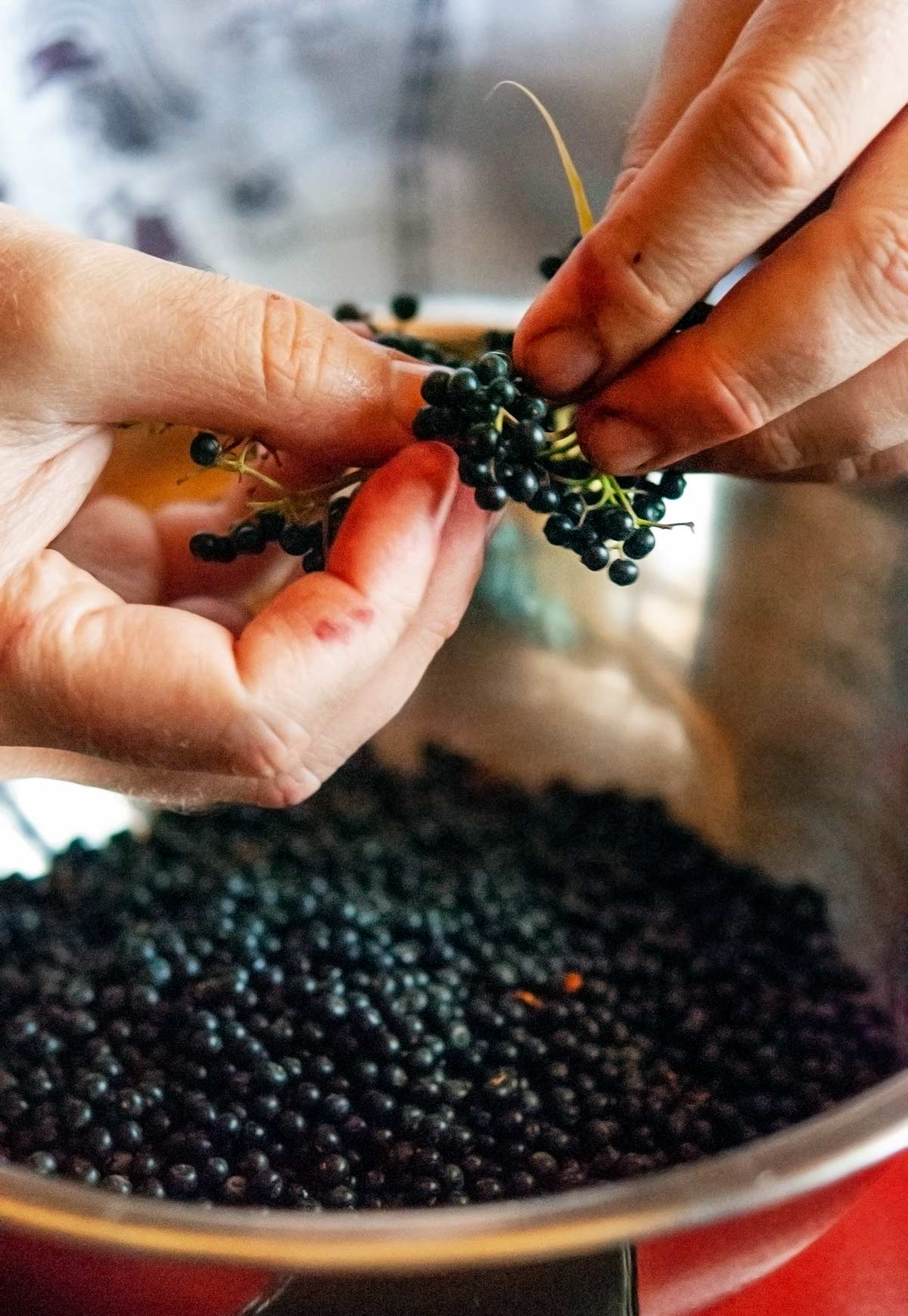
This is the least fun part of dealing with elderberries, but it needs to be done: The stems and leaves of the plant are toxic, and definitely bitter. You need to be patient and have a light hand, however, as the berries are fragile. Work with small portions of each cluster at a time, and gently rake your half-open hand over the berries, letting them fall into a bowl set beneath you.
Again, let me stress the word “gentle.” Unripe berries hold onto the stem, ripe ones fall off easily. And you don’t want to eat unripe berries.
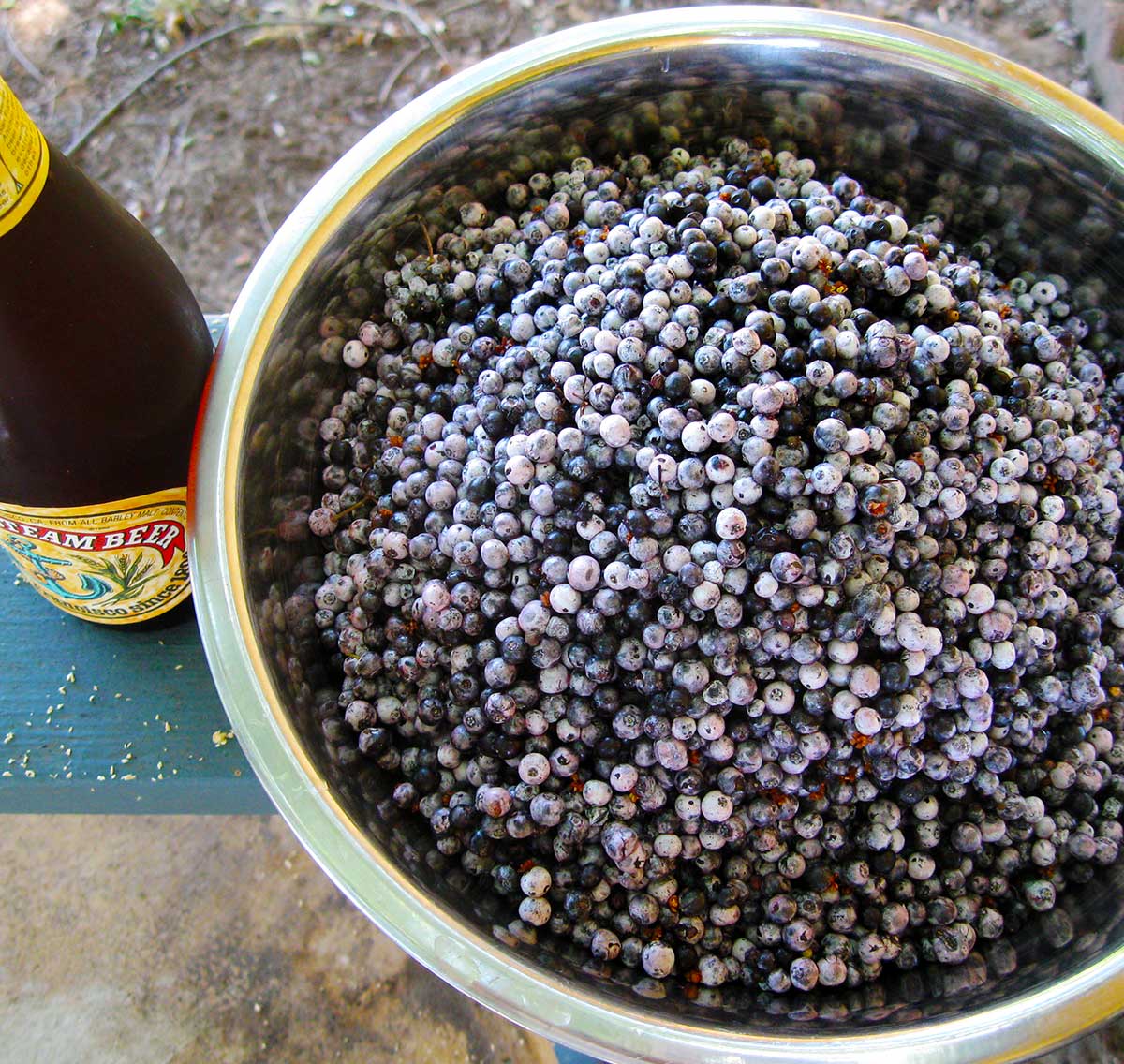
Cooking with Elderberries
What to do with all these berries? Admire them, to start. Poured into a large, flat Tupperware, they look like $10,000 worth of caviar: Shiny, tiny black orbs. So pretty! Dip your face close, and you will get the unmistakable aroma of winegrapes.
It was at this moment I realized just how good these could be in the hands of a competent winemaker — only you’ll never find one working with elderberries in California, as this place heaps so much scorn on “fruit” wines that I can barely mention them in public. Tyranny of the Grape, I call it.
I make elderberry wine every couple years. To do it right you need a lot of berries. I reckon at least 3 pounds per gallon, and 5 pounds per gallon is better.
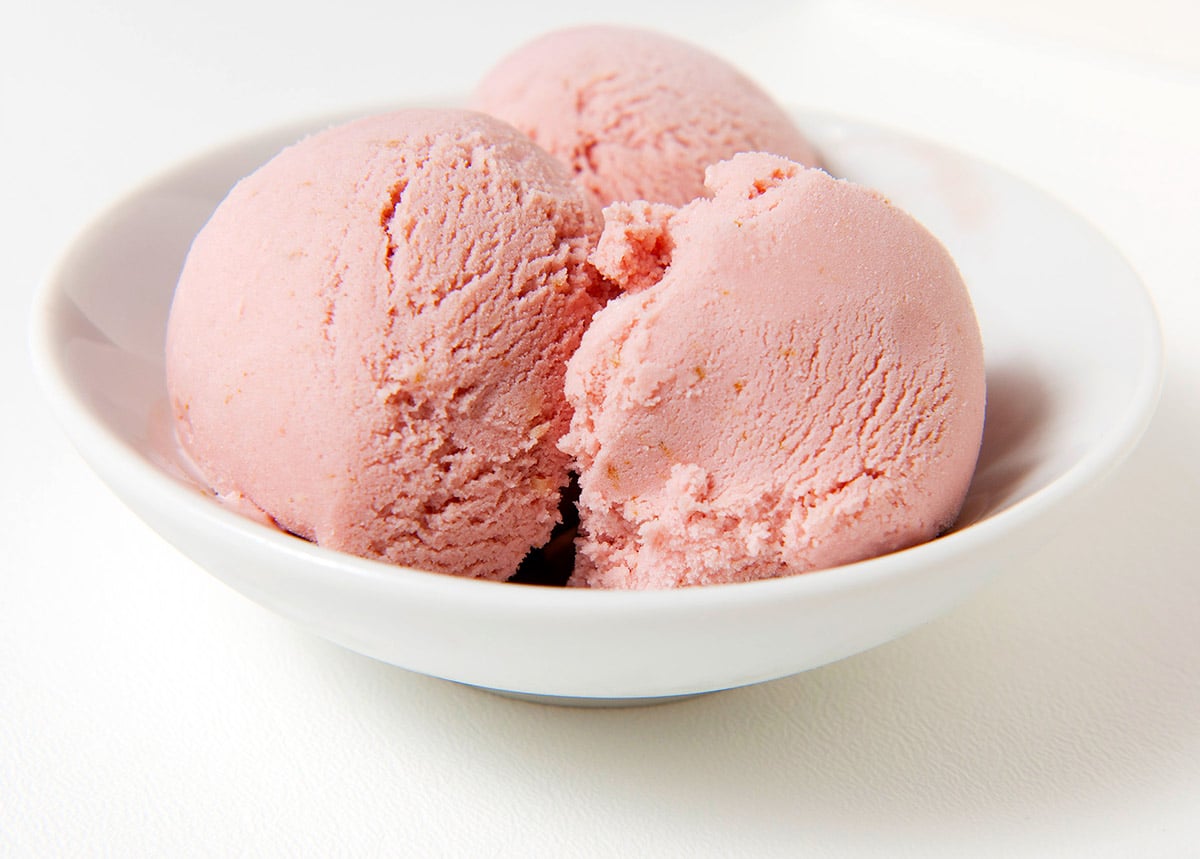
I also make elderberry liqueur with whole berries in vodka with lemon zest. It’s damn good with just a little bit of added sugar.
Elderberry syrup is a great base for the classic Cumberland sauce I make to go with wild game such as duck and venison. You can also use the syrup to make an Elderberry Ice Cream.
The British also make a curious condiment with elderberries called Pontack. It’s a little like a vinegary mashup between elderberry syrup and Worcestershire. It’s really good with venison and duck.
Preserving Elderberries
May favorite ways to preserve the harvest from elderberry season are the aforementioned syrup, wine, liqueur, and pontack. But after harvesting elderberries you can dehydrate them for another day. Set your dehydrator to 135°F for, well, a while. It takes up to 14 hours to get them leathery.
You can also pickle elderberries in a similar way to pickled blueberries.






i live in new orleans, and we are lousy with ripe elderberries right now. and we have been for weeks. what i use is an afro pick- one used to fluff up an angela davis-style fro- the kind with stainless steel tines- so much better than a fork, and far easier to use. btw, i ate raw elderberries several times as a kid, always trying to find ones that were even a little tasty- but never did. it was only when i dared to try my friend’s elderberry syrup which she had been raving about for years that i discovered the incredibly rich taste sensation that had always eluded me before. who could have known that such a bland, unappetizing fruit could have such potential when cooked?! it was quite a revelation, and now i just can’t ever get enough, so i raid every neglected bush i find and put them up to use or give away. what a treat!
The easiest way to remove the berries is by useing a fork, pull it down through the berries they come of with no problem, and you don,t get stained hands.
Forrest: Sigh. I don’t know how many times I need to say this, but I will say it one more time: MANY people can eat raw elderberries with no ill effects. I’ve been eating them for years right off the bush. They are NOT a powerful emetic at all. If you barfed like crazy, then it was most likely some other food you ate. Unless you are allergic, the worst it will do to you is give you an upset stomach and the runs.
Re: elderberries being toxic. RAW elderberries are a powerful emetic. I know this from personal experience. This is true at least of the Central Sierra berries. They must be cooked before being eaten, like rhuebarb. Repeat: do not eat raw elderberries!
Do elderberries ripen on the stems after picking? I picked some berries that were a bit reddish to save them from the birds.
I now live in France and my cottage has what I have been told are many elderberry trees. I don’t know this plant, we don’t have it in Australia…that i know of. The french think it’s poisonous but the British who have visited told me to make elderberry wine or syrup. The berries have turned from green to red now it’s August 2nd. When should I pick them? I will have bucket loads I am sure. How long will they keep stored for as syrup or jams? It sounds delicious reading all the recipes, and healthy too.
I made a great elderberry wine with dried ones bought online. You can give it more of a mouthfeel by adding in some raisins, I use about 1/2 and 1/2. I love fruit wines, but this one is the only one I’ve made yet that I really believe is every bit as good as grape wines. If you feel like you don’t have enough to make wine with, just add some chopped raisins or dried elderberries.
Try using crab apples with your elderberry juice, as much as half and half. In Pennsylvania this is common, many old farms have trees with unused fruit, never a problem with having enough pectin for it to jell also made the juice and canned it in the summer and not so bad to heat up the kitchen when it was cold. It was fun to make a turn of jelly and entertain the kids then.
.
I read most of the comments. I make jelly and do not have a problem with it getting thick and it is beautiful jelly. I also juice my berries in my steamer juicer with the stems and green berries on after washing them in a bath of water and salt removes bugs,with a second clear water rinse. I also remove some by hand to freeze for smoothy’s they are great in icecream to. The blooms can be dipped in sweet batter then deep fried and sprinkled with powdered sugar. I live in Oklahoma and have seen them all over the US. Hope you try some of these tips. One more thing depeneing on the strength of the berry juice. I dilute my juice with water to make my jelly 50/50.
We freeze the elderberries after picking them because the berries pop off the stems really easily when frozen…10 minutes to de-stem 10lbs of berries. Flavour is still fantastic.
I didn’t see this tip in the article or comments, forgive if I missed it and I’m sucking eggs, but you will removed the berries far faster if you strip them off with a fork. Just slide the tines of the fork in between the berries and pull up on the stalks. The berries ping off into the bowl. Hey presto!
My husband & I are huge elderberry fans! Loved your informative web site. We have been using a pectin by the name of Pamona’s Universal Pectin and we have had 100% success with the jelling aspect of the process. You can find Pamona’s at health food stores and Whole Foods also carries it. If you would like our jelly recipe let me know and I will gladly share it with you. Sincerely, Annie
I want to make elderberry jam not jelly,because the skins contain most of the nutrients, and use stevia, because it is healthier than sugar, but I cannot find any recipes for this combination. Please let me know if you have a recipe or a reference. Its so exciting to have these healthful berries so readily available. I want to make the best use of them.
If you Freeze berries with stems then berries come soooooooo much easier cut 1/4 time.
I make elderflower wine. Bottle half and distill the other half of a 25 litre brewing barrel. When the elderberries are ready I make elderberry wine and syrup. The syrup I back blend with the elderflower brandy and it is popular! Call it the best cough syrup you ever had – natural and full of anti viral goodness. Great over ice-cream – for adults, and a sweet nip for the sweet toothed out there.
I found your site while in search of a sauce/jam/jelly for venison as I have a request from a hunter who is also a bit of a foodie thanks to his very capable wife – my sister in law.
I will follow your blog with interest.
Raewyn.
Greetings. Just finished my first batch of elderberry jelly here in Boise. Am also going to be making some tincture using vodka for flu season. Decades ago my husband made preserves from Sierra elderberries using wild honey and it was delicious. We freeze the berries prior to removing from the stem then refreeze until use. Since winter is late in arriving we are still picking in the hills below 3,500′. Happy preserving and consuming!! Thankfully thankful.
Ryan: Great tips! Will pick a few extra pounds for that next season…
you can dry them on a tray in the sun. and use them in muffins or pancakes later. you can rehydrate them
I use to pick black elderberries along the flood control ditches in the Alvarado Niles district of Santa Clara by the bucket full. My brother and I made wine. I still have cases of this slightly dry berry flavored wine. Last time I was down that way I couldn’t find more that a bush or two and every thing is fenced off. When I was young this was all farm land now it is track after track of people.
I moved to Alaska in the 80’s I had several red elderberry bushes but they were mealy and terrible tasting, Early in the winter the magpies would get drunk eating them and provide me with the most entertaining clown show.
Last week I found a bush in the hills above the Carquinez Straits what a treat it is to be here making this jelly that won’t jell.
We picked elderberries with a friend back in August–at a lovely u-pick farm. At the time, I had a ton of other projects going and couldn’t deal with the berries, so I just froze them, right on the stems. From talking and reading about other people’s accounts of removing berries from the stems, it seems that freezing them first makes it a heck of a lot easier. Because the berries were frozen, it was easy to grab a bunch as a time without worrying about squeezing them too hard. My fingers didn’t get stained at all. I de-stemmed a gallon’s worth in 15 minutes or so, then put them back in the freezer. I’ll process them in the next week or so–syrup and some jelly, I think.